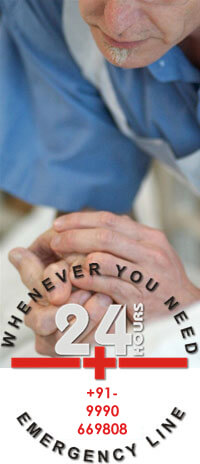Learn Adult CPR in New Delhi
There is no substitute for learning cardiopulmonary resuscitation (CPR), but emergencies don't wait for training. These instructions are for conventional adult CPR. If you've never been trained in CPR and the victim collapsed in front of you, use hands-only CPR.
Infant CPR for kids under 1 year.
Child CPR for kids 1-8 years old.
These are the steps to perform adult CPR:
Difficulty: Easy
Time Required: CPR should start as soon as possible
Here's How:
Attempt to wake victim. If the victim is not breathing (or is just gasping for breath), call 112 immediately and go to step 2. If someone else is there to help, one of you call 112 while the other moves on to step 2.
If the victim is breathing, see the Tips section at the bottom of this page for what to do.
Begin chest compressions. If the victim is not breathing, place the heel of your hand in the middle of his chest. Put your other hand on top of the first with your fingers interlaced. Compress the chest at least 2 inches (4-5 cm). Allow the chest to completely recoil before the next compression. Compress the chest at a rate of at least 100 pushes per minute. Perform 30 compressions at this rate (should take you about 18 seconds).
If you are not trained in CPR, continue to do chest compressions until help arrives or the victim wakes up.
It's normal to feel pops and snaps when you first begin chest compressions - DON'T STOP! You're not going to make the victim worse.
Begin rescue breathing. If you have been trained in CPR, after 30 compressions, open the victim's airway using the head-tilt, chin-lift method. Pinch the victim's nose and make a seal over the victim's mouth with yours. Use a CPR mask if available. Give the victim a breath big enough to make the chest rise. Let the chest fall, then repeat the rescue breath once more. If the chest doesn't rise on the first breath, reposition the head and try again. Whether it works on the second try or not, go to step 4.
If you don't feel comfortable with this step, just continue to do chest compressions at a rate of at least 100/minute.
Repeat chest compressions. Do 30 more chest compressions just like you did the first time.
Repeat rescue breaths. Give 2 more breaths just like you did in step 3 (unless you're skipping the rescue breaths).
Keep going. Repeat steps 4 and 5 for about two minutes (about 5 cycles of 30 compressions and 2 rescue breaths).
If you have access to an automated external defibrillator (AED), continue to do CPR until you can attach it to the victim and turn it on. If you saw the victim collapse, put the AED on right away. If not, attach it after approximately one minute of CPR (chest compressions and rescue breaths).
After 2 minutes of chest compressions and rescue breaths, stop compressions and recheck victim for breathing. If the victim is still not breathing, continue CPR starting with chest compressions. Repeat the process, checking for breathing every 2 minutes (5 cycles or so), until help arrives. If the victim wakes up, you can stop CPR.
Tips: Chest compressions are extremely important. If you are not comfortable giving rescue breaths, still perform chest compressions! It's called Hands Only CPR.
Watch the Hands Only CPR Video.
If the victim is breathing, briskly rub your knuckles against the victim's sternum. If the victim does not wake, call 112.
If the victim wakes up, but is confused or not able to speak, call 112. This is not a substitute for actual CPR training. Find a CPR class and get proper training.
Not every CPR class is the same. There are CPR classes for healthcare professionals as well as CPR classes for the layman. Before you take a CPR class, make sure the class is right for you.
For more information on these steps go to the Emergency Cardiac Care (ECC) Guidelines from the American Heart Association.
adult cpr steps, cpr steps for adults, cpr steps red cross, cardiopulmonary resuscitation steps, cpr steps, red cross cpr steps, cpr steps adults, steps for performing cpr on adults, adult cpr, how to perform cpr, 7 steps of cpr, how to perform cpr red cross, cpr steps adult, cpr adult steps, steps to adult cpr, steps for adult cpr, how to give cpr, steps of cpr, cpr in adults steps, how to perform adult cpr, cpr training steps, steps to perform cpr, cpr technique for an adult, cpr instructions, steps of adult cpr


































